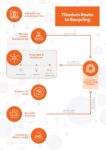In a rare and expansive demonstration of NATO’s airborne intelligence capabilities, the Royal Air Force (RAF) deployed its RC-135W Rivet Joint signals intelligence aircraft and a P-8A Poseidon maritime patrol aircraft on a coordinated 10,000-mile mission spanning the entire eastern flank of NATO territory. The operation underscores the alliance’s emphasis on persistent ISR (Intelligence, Surveillance, and Reconnaissance) coverage from the High North to the Black Sea amid ongoing tensions with Russia.
Strategic Scope: From Arctic Waters to the Black Sea
The October 10–11 mission saw both aircraft depart RAF Waddington in Lincolnshire and conduct synchronized patrols covering the Norwegian Sea, Baltic region, Eastern Europe, and the Black Sea. The RC-135W Rivet Joint—tail number ZZ664—conducted SIGINT collection over Poland and Romania before extending its orbit near NATO airspace adjacent to Crimea. Meanwhile, the P-8A Poseidon—tail number ZP805—focused on maritime surveillance over the Baltic Sea before heading south along the Romanian coast.
This dual-aircraft operation marked one of the longest single-day deployments for UK ISTAR assets since Russia’s full-scale invasion of Ukraine in February 2022. The sortie lasted approximately 15 hours for each platform and covered over 16,000 km (10,000 miles), showcasing not only endurance but operational reach across multiple theaters.
ISR Synergy: SIGINT Meets Maritime Domain Awareness
The pairing of Rivet Joint and Poseidon platforms reflects an increasingly integrated approach to multi-domain ISR. While the RC-135W specializes in intercepting electronic emissions—including radar signatures and communications—the P-8A provides high-resolution EO/IR imaging and synthetic aperture radar (SAR) coverage optimized for surface vessel tracking and submarine detection.
According to RAF statements reviewed by MiliVox via MOD press releases and open-source ADS-B tracking data from platforms like ADSBExchange and PlaneRadar.ru, both aircraft operated under NATO tasking but retained national command authority. Their overlapping orbits allowed cross-cueing between ELINT/SIGINT data collected by ZZ664 and visual/maritime confirmation by ZP805. This fusion supports rapid threat identification—such as Russian naval movements or radar activity—and enhances real-time situational awareness for allied commands.
Persistent Surveillance Amid Russian Military Posturing
The timing of this long-range ISR sortie is notable. It coincided with increased Russian naval deployments in both Kaliningrad Oblast and Sevastopol following recent Ukrainian strikes on Black Sea Fleet assets using long-range ATACMS missiles. Open-source analysts observed heightened Russian radar emissions near Crimea during the same window as ZZ664’s orbit—a likely target for SIGINT collection.
Moreover, this mission follows an uptick in RAF surveillance flights over Eastern Europe since mid-2023 when the UK Ministry of Defence expanded its forward-deployed ISTAR footprint under Operation Azotize. The operation supports NATO Enhanced Vigilance Activities (eVA) along alliance borders with Belarus and Russia.
“This type of coordinated deployment sends a clear signal,” said a former RAF ISTAR Group commander contacted by MiliVox. “It demonstrates that we can surveil multiple domains simultaneously—from subsurface threats to electromagnetic spectrum anomalies—and do so at strategic depth.”
Platform Capabilities: RC-135W Rivet Joint vs P-8A Poseidon
The Boeing RC-135W Rivet Joint is operated by No. 51 Squadron RAF under U.S.-UK cooperative agreements that include embedded USAF personnel onboard. It features extensive COMINT/ELINT suites capable of detecting radar emissions across VHF/UHF/S-band spectrums as well as direction-finding arrays for emitter geolocation.
- Crew: ~30 (including linguists/electronic warfare officers)
- Range: ~7,500 km without refueling
- Sensors: Multiple passive receivers; no offensive armament
The P-8A Poseidon is derived from Boeing’s 737NG airframe but militarized for anti-submarine warfare (ASW), anti-surface warfare (ASuW), SAR missions, and maritime domain awareness:
- Crew: ~9–11 mission crew
- Sensors: AN/APY-10 radar; EO/IR turret; sonobuoy launchers; MAD sensors
- Munitions: Can carry Mk54 torpedoes; Harpoon missiles; depth charges
- Range: ~7,400 km; endurance ~10 hours unrefueled
This pairing allows for dynamic tasking against both land-based emitters (Rivet Joint) and naval/subsurface threats (Poseidon), making it ideal for coverage along contested littorals like those off Kaliningrad or Crimea.
NATO Integration & Forward Posture Evolution
The sortie aligns with broader NATO efforts to enhance persistent surveillance along its eastern flank through rotational deployments rather than permanent basing—a strategy designed to remain compliant with existing treaties while maintaining readiness. Since early 2023, allied nations including Norway, Romania, Poland, Germany, Turkey, and Bulgaria have hosted increased numbers of ISR sorties under eVA mandates.
The UK has invested heavily in its ISTAR fleet post-Brexit to maintain relevance within Five Eyes intelligence sharing frameworks while also reinforcing European deterrence architectures. The RAF currently operates three Rivet Joints leased via Foreign Military Sales from USAF inventory under Project Airseeker alongside nine P-8As acquired through Boeing deliveries completed in early 2024.
Operational Takeaways & Future Outlook
This joint long-range patrol highlights several key trends shaping modern airpower employment:
- Manned ISR remains essential despite UAV proliferation;
- SIGINT/ELINT fusion with maritime domain awareness provides multi-domain advantage;
- NATO airspace coverage is increasingly layered—from Arctic to Black Sea;
- Loyal Wingman-style UAVs may eventually augment such missions but not replace them yet.
The success of this operation will likely inform future planning cycles within NATO AIRCOM as it balances persistent surveillance needs against contested A2/AD environments posed by Russian S-400/Su-35 networks. Expect more such integrated sorties involving manned-unmanned teaming concepts once platforms like Protector RG Mk1 enter full service later this decade.









